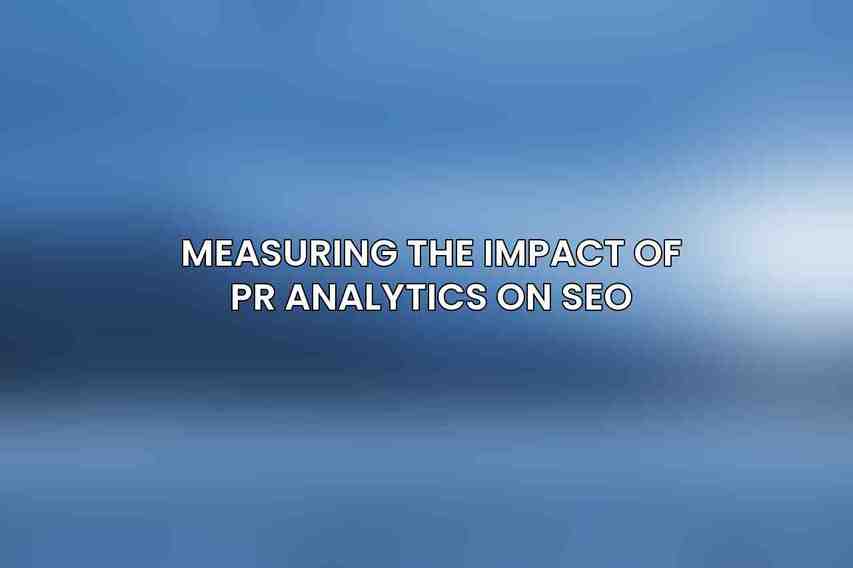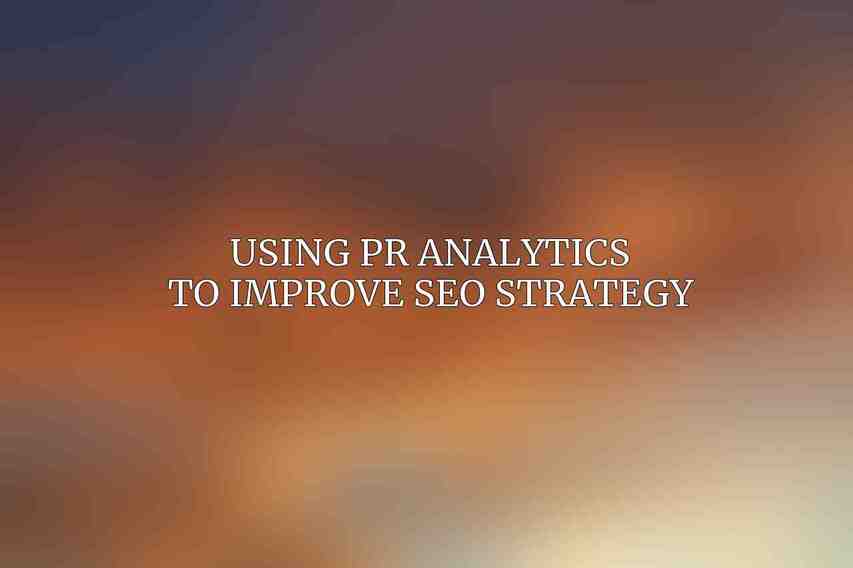Understanding and analyzing pr analytics play a crucial role in shaping a successful seo strategy. public relations (pr) analytics provide insights into the impact of communication efforts, helping organizations make data-driven decisions to enhance their online presence. Effective interpretation of PR analytics can significantly boost a brand’s visibility and credibility in the online sphere. This guide aims to break down key PR analytics metrics and strategies for leveraging them to improve SEO performance.
Understanding PR Analytics Data
A. Earned Media Value (EMV)
Earned Media Value (EMV) is a critical metric in PR analytics that quantifies the value of publicity gained through various channels. It is essential for businesses to calculate EMV accurately to understand the returns on their PR efforts. By comparing EMV against benchmarks specific to the industry, organizations can gauge the effectiveness of their PR campaigns. Factors such as media coverage, audience size, and engagement levels influence the calculation of EMV, making it a versatile metric for evaluating PR success.
B. Reach and Impressions
Distinguishing between reach and impressions is vital in analyzing the effectiveness of PR campaigns. While reach measures the total number of unique viewers who see content, impressions track the number of times content is displayed, regardless of repetition. To maximize reach and impressions, businesses should focus on utilizing metrics like shares, retweets, and likes to extend the organic reach of their content. Implementing strategies such as collaborating with influencers and optimizing content for shareability can amplify these metrics, thereby enhancing brand visibility. Find more on Success Stories: How PR Analytics Transformed Press Release Outcomes
C. Engagement Metrics
Engagement metrics encompass actions taken by users in response to PR content, such as likes, shares, and comments. These metrics provide valuable insights into audience interactions and preferences, influencing SEO rankings directly. High levels of engagement signal to search engines that the content is valuable and relevant, potentially boosting its ranking in search results. To enhance engagement, businesses can employ strategies like creating interactive content, fostering community participation, and responding to audience feedback promptly.
D. Sentiment Analysis
Sentiment analysis involves evaluating the emotional tone and attitudes expressed in PR content to gauge public perception accurately. Utilizing tools that analyze sentiment can help businesses understand how their brand is perceived online, allowing for targeted adjustments to PR and SEO strategies. By leveraging sentiment analysis, organizations can tailor their messaging to align with audience sentiment, thereby enhancing brand reputation and SEO performance.
E. Backlinks
Backlinks are essential components of a robust SEO strategy, influencing a website’s credibility and authority in search engine rankings. The quality and quantity of backlinks pointing to a site are crucial metrics in assessing its SEO performance. Organizations can acquire high-quality backlinks through strategies like guest blogging, influencer partnerships, and content collaborations. Monitoring backlink metrics regularly and focusing on securing relevant and reputable backlinks can significantly enhance a website’s SEO visibility.
Measuring the Impact of PR Analytics on SEO

A. Tracking SEO Ranking Improvements
Tracking the correlation between PR metrics and SEO rankings is vital in evaluating the impact of PR analytics on SEO performance. Various tools and software can assist businesses in monitoring changes in search engine rankings resulting from PR campaigns. By aligning PR efforts with SEO goals and tracking improvements in search rankings, organizations can optimize their overall online visibility and credibility.
B. Analyzing Organic Traffic and Conversions
PR analytics play a significant role in driving organic traffic to a website, leading to increased conversions and sales. By analyzing metrics related to organic traffic sources and conversion rates, businesses can assess the effectiveness of their PR strategies in generating leads and conversions. Understanding how PR activities contribute to organic traffic growth enables organizations to fine-tune their campaigns for better ROI and conversion rates.
C. Establishing a Baseline and Setting Goals
Setting clear goals based on PR analytics is essential for measuring the effectiveness of SEO strategies. Establishing a baseline performance level allows businesses to track progress and adjust their tactics accordingly. By continuously monitoring PR analytics and setting achievable goals, organizations can ensure a consistent improvement in their SEO performance over time.
Using PR Analytics to Improve SEO Strategy

A. Identifying Opportunities for Growth
Analyzing PR data can uncover valuable insights and opportunities for enhancing SEO performance. By identifying areas with potential for improvement, businesses can tailor their SEO strategies to capitalize on PR successes and further boost online visibility. Leveraging PR analytics to identify growth opportunities allows organizations to stay ahead of competitors and maximize their SEO impact.
B. Optimizing Content for SEO
Incorporating keywords and insights from PR data into content creation is essential for optimizing SEO performance. By aligning content with audience preferences identified through sentiment analysis, businesses can create more engaging and relevant material that resonates with online users. This alignment not only enhances SEO rankings but also improves overall brand perception and relevance in the digital world.
C. Building Relationships with Influencers and Journalists
Nurturing relationships with influencers and journalists is a strategic approach to amplifying PR efforts and expanding online reach. By leveraging PR analytics to identify key influencers and media contacts, businesses can establish mutually beneficial partnerships that drive brand visibility and engagement. Cultivating these relationships fosters trust and credibility, ultimately boosting SEO performance through increased brand mentions and backlinks.
D. Monitoring and Adjusting PR Strategy
Regular review of PR analytics is crucial for tracking progress and adapting strategies to meet evolving business goals. By constantly monitoring PR data and performance metrics, organizations can identify areas for improvement and make informed decisions about future PR campaigns. Utilizing data-driven insights to adjust PR strategies ensures continuous optimization and alignment with SEO objectives.
interpreting PR analytics is a cornerstone of developing a robust SEO strategy that drives online success. By understanding and leveraging key PR metrics, businesses can enhance their visibility, engagement, and credibility in the digital world. Emphasizing the importance of data-driven decision-making and ongoing monitoring of PR analytics can significantly impact SEO performance and ensure long-term success in the ever-evolving online environment. Constant optimization and adaptation of PR strategies based on analytics insights are critical for staying competitive and maximizing SEO impact. By prioritizing the interpretation of PR analytics, businesses can secure a strong position in search engine rankings and effectively reach their target audiences.
For more information and resources on PR analytics and SEO strategy, feel free to explore additional articles on PR measurement tools and SEO best practices!
Frequently Asked Questions
What are PR analytics?
PR analytics refers to the measurement and analysis of public relations efforts to assess their effectiveness and impact on key performance indicators.
Why are PR analytics important for SEO strategy?
PR analytics can provide valuable insights into the performance of your PR efforts, which can help inform your SEO strategy and enhance overall marketing efforts.
What key metrics should you monitor in PR analytics for SEO purposes?
Some key metrics to monitor in PR analytics for SEO purposes include website traffic, backlinks, keyword visibility, brand mentions, and social shares.
How can PR analytics help improve SEO performance?
By analyzing PR analytics data, you can identify areas for improvement, track the success of PR campaigns, optimize content for search engines, and ultimately drive more traffic to your website.
What are some tools for interpreting PR analytics for better SEO strategy?
Some popular tools for interpreting PR analytics for better SEO strategy include Google Analytics, SEMrush, Ahrefs, Moz, and BuzzSumo. Read more on A Comprehensive Guide to PR Analytics: Understanding Impact

